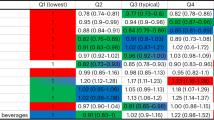Abstract
Background/Objectives:
Although numerous equations to predict percent body fat have been published, few have broad generalizability. The objective of this study was to develop sets of equations that are generalizable to the American population 8 years of age and older.
Subjects/Methods:
Dual-emission X-ray absorptiometry (DXA) assessed percent body fat from the 1999–2006 National Health and Nutrition Examination Survey (NHANES) was used as the response variable for development of 14 equations for each gender that included between 2 and 10 anthropometrics. Other candidate variables included demographics and menses. Models were developed using the Least Absolute Shrinkage and Selection Operator (LAASO) and validated in a ¼ withheld sample randomly selected from 11 884 males or 9215 females.
Results:
In the final models, R2 ranged from 0.664 to 0.845 in males and from 0.748 to 0.809 in females. R2 was not notably improved by development of equations within, rather than across, age and ethnic groups. Systematic over or under estimation of percent body fat by age and ethnic groups was within 1 percentage point. Seven of the fourteen gender-specific models had R2 values above 0.80 in males and 0.795 in females and exhibited low bias by age, race/ethnicity and body mass index (BMI).
Conclusions:
To our knowledge, these are the first equations that have been shown to be valid and unbiased in both youth and adults in estimating DXA assessed body fat. The equations developed here are appropriate for use in multiple ethnic groups, are generalizable to the US population and provide a useful method for assessment of percent body fat in settings where methods such as DXA are not feasible.
This is a preview of subscription content, access via your institution
Access options
Subscribe to this journal
Receive 12 print issues and online access
$259.00 per year
only $21.58 per issue
Buy this article
- Purchase on Springer Link
- Instant access to full article PDF
Prices may be subject to local taxes which are calculated during checkout



Similar content being viewed by others
References
Cui Z, Truesdale KP, Cai J, Stevens J . Evaluation of anthropometric equations to assess body fat in adults: NHANES 1999-2004. Med Sci Sports Exerc 2014; 46: 1147–1158.
Chambers AJ, Parise E, McCrory JL, Cham R . A comparison of prediction equations for the estimation of body fat percentage in non-obese and obese older Caucasian adults in the United States. J Nutr Health Aging 2014; 18: 586–590.
Norgan NG . Laboratory and field measurements of body composition. Public Health Nutr 2005; 8: 1108–1122.
Dugas LR, Cao G, Luke AH, Durazo-Arvizu RA . Adiposity is not equal in a multi-race/ethnic adolescent population: NHANES 1999-2004. Obesity (Silver Spring) 2011; 19: 2099–2101.
Stevens J, Cai J, Truesdale KP, Cuttler L, Robinson TN, Roberts AL . Percent body fat prediction equations for 8- to 17-year-old American children. Pediatr Obes 2013; 9: 260–271.
Zanovec M, Wang J, O'Neil CE . Development and comparison of two field-based body fat prediction equations: NHANES 1999-2004. Int J Exerc Sci 2012; 5: 5.
Li C, Ford ES, Zhao G, Balluz LS, Giles WH . Estimates of body composition with dual-energy X-ray absorptiometry in adults. Am J Clin Nutr 2009; 90: 1457–1465.
Heo M, Faith MS, Pietrobelli A, Heymsfield SB . Percentage of body fat cutoffs by sex, age, and race-ethnicity in the US adult populaton from NHANES 1999-2004. Am J Clin Nutr 2012; 95: 594–602-60.
Pratt CA, Boyington J, Esposito L, Pemberton VL, Bonds D, Kelley M et al. Childhood Obesity Prevention and Treatment Research (COPTR): interventions addressing multiple influences in childhood and adolescent obesity. Contemp Clin Trials 2013; 36: 406–413.
Tibshirani RJ . Regression Shrinkage and Selection via the LASS. J R Stat Soc 1996. Ser. B 58: 267–288.
Centers for Disease Control and Prevention (CDC). National Center for Health Statistics (NCHS). National Health and Nutrition Examination Survey Examination Protocol. Hyattsville, MD, USA: US Department of Health and Human Services, Centers for Disease Control and Prevention 2011, http://www.cdc.gov/nchs/nhanes.htm.
Johnson CL, Paulose-Ram R, Ogden CL, Carroll MD, Kruszon-Moran D, Dohrmann SM et al. National health and nutrition examination survey: analytic guidelines, 1999-2010. Vital Health Stat 2 2013; 161: 1–24.
Schoeller DA, Tylavsky FA, Baer DJ, Chumlea WC, Earthman CP, Fuerst T et al. QDR 4500A dual-energy X-ray absorptiometer underestimates fat mass in comparison with criterion methods in adults. Am J Clin Nutr 2005; 81: 1018–1025.
Hastie T, Tibshirani R, Friedman J . The Elements of Statistical Learning. Springer New York Inc.: New York, NY, USA, 2001, pp 244.
Rothman KJ, Greenland S, Lash TL . Modern Epidemiology, 3rd edn. Wolters Kluwer Health/Lippincott Williams & Wilkins: Philadelphia, PA, USA, 2008.
Burton RF . The body adiposity index is not the best hip-height index of adiposity. Br J Nutr 2012; 108: 2100–2101.
Acknowledgements
This work was supported by the National Institute of Diabetes and Digestive and Kidney Diseases (R01-DK097046).
Author information
Authors and Affiliations
Corresponding author
Ethics declarations
Competing interests
The authors declare no conflict of interest.
Additional information
Supplementary Information accompanies this paper on International Journal of Obesity website
Rights and permissions
About this article
Cite this article
Stevens, J., Ou, FS., Cai, J. et al. Prediction of percent body fat measurements in Americans 8 years and older. Int J Obes 40, 587–594 (2016). https://doi.org/10.1038/ijo.2015.231
Received:
Revised:
Accepted:
Published:
Issue Date:
DOI: https://doi.org/10.1038/ijo.2015.231
This article is cited by
-
More hypoglycemia not associated with increasing estimated adiposity in youth with type 1 diabetes
Pediatric Research (2023)
-
Equations based on anthropometric measurements for adipose tissue, body fat, or body density prediction in children and adolescents: a scoping review
Eating and Weight Disorders - Studies on Anorexia, Bulimia and Obesity (2022)
-
Non-linear association of anthropometric measurements and pulmonary function
Scientific Reports (2021)
-
Relative Fat Mass as an estimator of whole-body fat percentage among children and adolescents: A cross-sectional study using NHANES
Scientific Reports (2019)
-
Relative fat mass (RFM) as a new estimator of whole-body fat percentage ─ A cross-sectional study in American adult individuals
Scientific Reports (2018)



